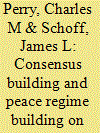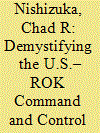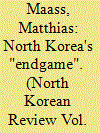| Srl | Item |
| 1 |
ID:
097345


|
|
|
| 2 |
ID:
162445


|
|
|
|
|
| Summary/Abstract |
The “transfer of wartime OPCON” from the United States to the Republic of
Korea, in conjunction with the termination of the obsolete Armistice Agreement,
may provide a unique opportunity for the Alliance to simplify and streamline
its command and control (C2) processes. The C2 structure in South Korea is
complicated by the coexistence of four distinct theater-level commands, the ROK
Joint Chiefs of Staff (JCS), United States Forces Korea (USFK), the Combined
Forces Command (CFC), and the United Nations Command (UNC), all of which
have a unique command structure and set of objectives. As the ROK continues
to grow stronger, both economically and politically, the four commands are
experiencing increasing difficulties synchronizing competing government policies.
The U.S. and ROK governments’ aptitude to address policy differences have a
direct impact on the ability of the four commands to achieve their end-states,
both individually and as a cohesive unit. This paper demonstrates that through the
reorganization of the Combined Forces Command and the elimination of conflicting
responsibilities emanating from the United Nations Command, the U.S.–ROK
Alliance could become more formidable by increasing simplicity, the unity of
command, and the span of control of the current C2 structure.
|
|
|
|
|
|
|
|
|
|
|
|
|
|
|
|
| 3 |
ID:
165782


|
|
|
|
|
| Summary/Abstract |
Article Type: Commentary Essay Purpose—Much of the debate on North Korea assumes that Pyongyang would be truly satisfied with the overall status quo if it were only safe and secure enough. The purpose here is to argue that Pyongyang may instead be looking for reunification from a position of strength. Method—The short paper is built mostly on secondary-source research. It uses short historical case studies in addition to professional writings, both academic and journalistic. Findings—Overall, the argument is that Pyongyang has never abandoned the goal of unifying the peninsula under its own leadership. In fact, its "endgame" is a DPRK that spans the entire peninsula and unites the entire Korean people. Implications—To go forward and work with a nuclear North Korea towards a mutually agreeable long-term arrangement on the peninsula, understanding the long-term goals of Kim Jong Un is critical. The argument presented here may instill more caution in negotiation partners and statesmen/-women, especially in Seoul, Washington, and Tokyo, but also in Beijing and Moscow.
|
|
|
|
|
|
|
|
|
|
|
|
|
|
|
|
| 4 |
ID:
141770


|
|
|
| 5 |
ID:
092003


|
|
|
|
|
| Publication |
2009.
|
| Summary/Abstract |
The rollback of North Korea's nuclear program is closely interwined with the peace process in the Korean peninsula and resuscitation of the Nuclear Nonproliferation Treaty(NPT). With the recent thaw in U.S.-North Korea relations, a new opportunity is emerging for the two koreas and the United States. The international community and the concerned parties cannot afford another failure given the imminent danger of the current security siuation on the peninsula and the resulting pressing need for peace building. It is time for them to make a serious effort to bring about a Korean peace that would, in turn, contribute to peace, prosperity, and democracy in the region and the rest of the world. This article looks at policy alternatives that will effectively bring solid and lasting peace to the Korean peninsula.
|
|
|
|
|
|
|
|
|
|
|
|
|
|
|
|